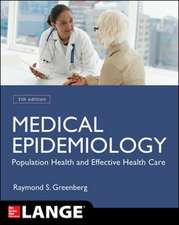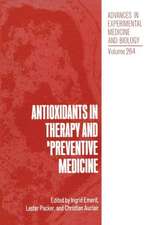Free Radicals and Aging: Experientia Supplementum, cartea 62
Autor Ingrid Emerit, Chanceen Limba Engleză Paperback – 26 apr 2012
Din seria Experientia Supplementum
- 5%
 Preț: 1343.50 lei
Preț: 1343.50 lei - 5%
 Preț: 984.91 lei
Preț: 984.91 lei -
 Preț: 330.76 lei
Preț: 330.76 lei -
 Preț: 282.83 lei
Preț: 282.83 lei -
 Preț: 302.84 lei
Preț: 302.84 lei -
 Preț: 192.21 lei
Preț: 192.21 lei - 5%
 Preț: 369.45 lei
Preț: 369.45 lei - 5%
 Preț: 382.62 lei
Preț: 382.62 lei - 15%
 Preț: 644.18 lei
Preț: 644.18 lei - 18%
 Preț: 944.51 lei
Preț: 944.51 lei - 18%
 Preț: 944.51 lei
Preț: 944.51 lei - 5%
 Preț: 715.55 lei
Preț: 715.55 lei - 15%
 Preț: 647.40 lei
Preț: 647.40 lei - 15%
 Preț: 646.94 lei
Preț: 646.94 lei - 5%
 Preț: 1430.00 lei
Preț: 1430.00 lei - 5%
 Preț: 1107.58 lei
Preț: 1107.58 lei - 5%
 Preț: 1048.73 lei
Preț: 1048.73 lei - 5%
 Preț: 902.80 lei
Preț: 902.80 lei - 5%
 Preț: 1294.47 lei
Preț: 1294.47 lei - 5%
 Preț: 1287.38 lei
Preț: 1287.38 lei - 18%
 Preț: 950.66 lei
Preț: 950.66 lei -
 Preț: 343.59 lei
Preț: 343.59 lei -
 Preț: 401.24 lei
Preț: 401.24 lei - 15%
 Preț: 666.24 lei
Preț: 666.24 lei -
 Preț: 344.36 lei
Preț: 344.36 lei -
 Preț: 383.33 lei
Preț: 383.33 lei -
 Preț: 503.74 lei
Preț: 503.74 lei -
 Preț: 388.52 lei
Preț: 388.52 lei - 15%
 Preț: 471.53 lei
Preț: 471.53 lei -
 Preț: 432.81 lei
Preț: 432.81 lei - 15%
 Preț: 480.09 lei
Preț: 480.09 lei -
 Preț: 400.47 lei
Preț: 400.47 lei -
 Preț: 377.18 lei
Preț: 377.18 lei -
 Preț: 481.58 lei
Preț: 481.58 lei - 18%
 Preț: 949.23 lei
Preț: 949.23 lei - 15%
 Preț: 505.96 lei
Preț: 505.96 lei -
 Preț: 381.43 lei
Preț: 381.43 lei -
 Preț: 390.08 lei
Preț: 390.08 lei -
 Preț: 463.41 lei
Preț: 463.41 lei -
 Preț: 424.22 lei
Preț: 424.22 lei -
 Preț: 467.43 lei
Preț: 467.43 lei -
 Preț: 381.21 lei
Preț: 381.21 lei
Preț: 383.34 lei
Preț vechi: 403.53 lei
-5% Nou
Puncte Express: 575
Preț estimativ în valută:
73.38€ • 79.73$ • 61.68£
73.38€ • 79.73$ • 61.68£
Carte tipărită la comandă
Livrare economică 21 aprilie-05 mai
Preluare comenzi: 021 569.72.76
Specificații
ISBN-13: 9783034874625
ISBN-10: 3034874626
Pagini: 456
Ilustrații: X, 444 p.
Dimensiuni: 191 x 235 x 24 mm
Greutate: 0.78 kg
Ediția:Softcover reprint of the original 1st ed. 1992
Editura: Birkhäuser Basel
Colecția Birkhäuser
Seria Experientia Supplementum
Locul publicării:Basel, Switzerland
ISBN-10: 3034874626
Pagini: 456
Ilustrații: X, 444 p.
Dimensiuni: 191 x 235 x 24 mm
Greutate: 0.78 kg
Ediția:Softcover reprint of the original 1st ed. 1992
Editura: Birkhäuser Basel
Colecția Birkhäuser
Seria Experientia Supplementum
Locul publicării:Basel, Switzerland
Public țintă
ResearchCuprins
I: The Intrinsic Aging Process.- Theoretical Considerations.- Free radical theory of aging: History.- Free radical theory of aging: View against the reliability theory.- The rate of DNA damage and aging.- Genetic stability and oxidative stress: Common mechanisms in aging and cancer.- Oxygen-induced mitochondrial damage and aging.- Biochemical Markers of Aging.- Instabilities of metabolic regulations in aging.- Protein modification in aging.- Mitochondrial production of oxygen free radicals in the heart muscle during the life span of the rat: Peak at middle age.- Lipofuscinogenesis in a model system of cultured cardiac myocytes.- Cellular clones and transgenic mice overexpressing copper-zinc superoxide dismutase: Models for the study of free radical metabolism and aging.- The importance of antioxidant enzymes in cellular aging and degeneration.- Relationship between antioxidants, lipid peroxidation and aging.- The metabolism of 4-hydroxynonenal, a lipid peroxidation product, is dependent on tumor age in Ehrlich mouse ascites cells.- Effect of aging on glutathione metabolism. Protection by antioxidants.- II. Age-Related Diseases.- Cardiovascular System.- Inhibition of LDL oxidation by antioxidants.- Desialylated low density lipoproteins and atherosclerosis.- Molecular basis of ?-tocopherol inhibition of smooth muscle cell proliferation in vitro.- Brain.- Oxidation damage in Alzheimer’s dementia, and the potential etiopathogenic role of aluminosilicates, microglia and micronutrient interactions.- The role of alterations in free radical metabolism in mediating cognitive impairments in Down’s syndrome.- Free radicals and neurotransmitters in gerbii brain. Influence of age and ischemia reperfusion insult.- Free radicals, lipid peroxidation, SOD activity,neurotransmitters and choline acetyltransferase activity in the aged rat brain.- Evidence for drug metabolism as a source of reactive species in the brain.- Cancer.- Anticarcinogenic activities of carotenoids in animals and cellular systems.- Aging and cancer: Plasma antioxidants and lipid peroxidation in young and aged breast cancer patients.- DNA damage in mammalian cell lines with different antioxidant levels and DNA repair capacities.- Variable ?-tocopherol stimulation and protection of glutathione peroxidase activity and non-transformed and transformed fibroblasts.- Assessing and counteracting the prooxidant effects of anticancer drugs.- Eye Disease.- Effect of photooxidation on the eye lens and role of nutrients in delaying cataract.- Carotenoids in the retina — A review of their possible role in preventing or limiting damage caused by light and oxygen.- Oxidative stress in diabetic retina.- Cartilage, Collagen and Skin.- Active oxygen species, articular inflammation and cartilage damage.- Oxidative damage to collagen.- Free radicals and aging of the skin.- Diabetes, Gastrointestinal Tract.- Modulators of free radical activity in diabetes mellitus: Role of ascorbic acid.- Possible role of free radicals in the chronic inflammation of the gut.- III. Epidemiologic Studies, Nutrition and Antioxidant Supplementation.- Age-related variations of enzymatic defenses against free radicals and peroxidates.- Antioxidant status (selenium, vitamins A and E) and aging.- Inverse correlation between essential antioxidants in plasma and subsequent risk to develop cancer, ischemic heart disease and stroke respectively: 12-year follow-up of the Prospective Basel Study.- Vitamin E requirement in relation to dietary fish oil and oxidative stress in elderly.- Vitamin C and vitamin E— synergistic interactions in vivo?.- The threshold of age in exercise and antioxidants action.- Antioxidant therapy in the aging process.- Acknowledgements.













